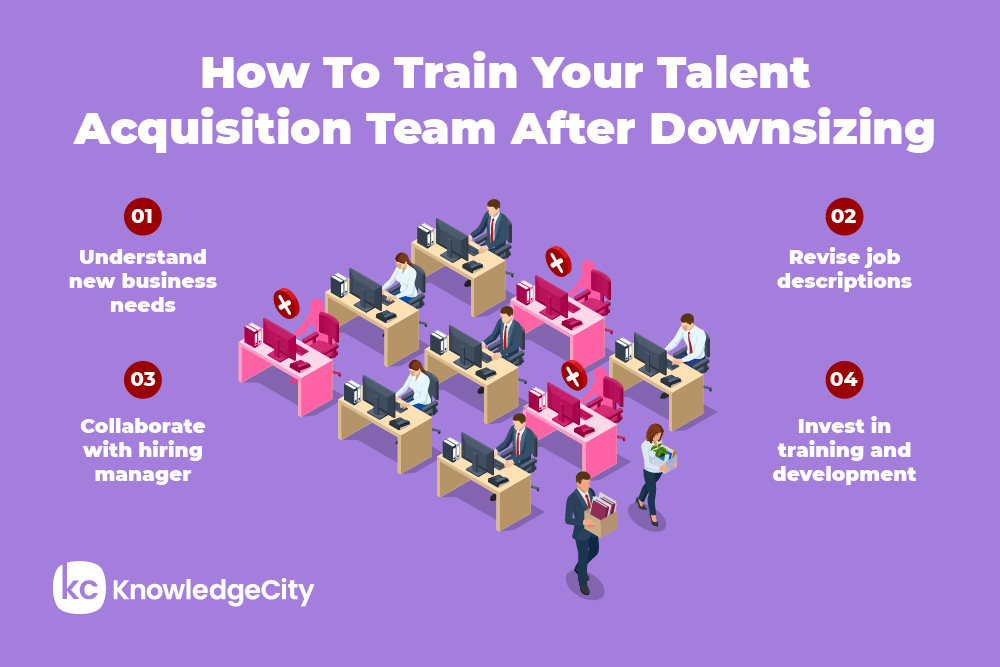Downsizing is typically driven by a combination of financial, strategic, and operational factors. The most common reasons include cost reduction, declining revenue, economic downturn, restructuring, mergers and acquisitions, technological advancements, global competition, and regulatory changes. Sometimes, downsizing can be simply due to the discontinuation of a product or service or a shift in strategy.
In any case, while talent acquisition may be paused during downsizing, finding the best people for your organization is a journey that never stops—especially after a significant change.

In this article, we provide:
- Primary reasons why rehiring after downsizing is different than the normal hiring process
- Tips on how to best train recruiters after downsizing
- A checklist for how to know when it’s the right time to start hiring again
The effects of downsizing are often both positive and negative. The positives include cost reduction, increased efficiency, and improved productivity, while the negatives include cultural impact, loss of institutional knowledge, and increased workload.
The last three are significant risks, and companies typically aim to manage downsizing effectively by minimizing these negative impacts on employees, while achieving their financial and strategic objectives.
Downsizing allows for cost-cutting and refocusing on core competencies, but it also results in low morale, increased stress, and decreased engagement. According to Risely, preventing burnout and fatigue is especially critical in the aftermath of layoffs. Therefore, proper planning and communication are essential when implementing downsizing to ensure as smooth a transition as possible.
Properly training your talent acquisition team after layoffs is a key aspect of effectively navigating this transition.
Hiring after layoffs is a delicate process that requires careful planning and execution to rebuild your workforce. Re-establishing teams requires a shift in recruitment practices to ensure that your organization can transform successfully.
As a result, post-layoff training for your talent acquisition team is essential to ensure they are equipped to handle your organization’s changing hiring needs while maintaining a positive work environment and supporting the company’s overall recovery and growth.
Compared to normal hiring processes, training recruiters for rehiring after downsizing involves several unique considerations.
In the aftermath of downsizing, preparing recruiters for talent acquisition involves a specific focus on the unique dynamics and sensitivities of the situation. Here is a list of helpful tips to remember when it comes to the differences between re-hiring after downsizing versus hiring during normal times:
- Recruiters need to be well-versed in the context of the downsizing
- Recruiters should be trained to play a role in rebuilding morale by emphasizing transparency, empathy, and communication
- Training should focus on recognizing transferable skills among internal candidates who are reapplying or being considered for new roles within the company
- Training should emphasize the importance of maintaining continuity in the workplace
- Recruiters need to understand how to present the company as a supportive and reliable employer
- Training should include guidance on onboarding and reintegration strategies to help returning employees adjust to their new roles and responsibilities
- Recruiters must be aware of any legal obligations and ethical considerations related to rehiring employees
- Recruiters should be trained in change management principles, as they may be recruiting employees who will be working in a transformed organization
How to best train your talent acquisition team after downsizing
This process requires several key strategies and skills. They include:
- Understanding the new business needs
- Revising job descriptions
- Reevaluating candidate profiles
- Enhancing networking skills
- Investing in training and development
- Using data-driven decision-making
- Collaborating with hiring managers
- Focusing on employee retention and monitoring
Determining the best time to re-hire
Assessing if your company is ready to hire depends on various factors. Ultimately, the best time to hire and whether your company is ready to hire depends on your unique circumstances and goals. According to Insperity, figuring out the right number of employees to hire after downsizing depends on three main factors:
- Demand
- Workload
- Affordability
Below is a more extensive list of items to consider when deciding whether to re-hire. By checking each one off, you can determine if it’s the right time for you to start onboarding talent again:
- Evaluate your organization’s current and future business needs
- Assess your current employees’ workloads and capacities
- Ensure that your company’s financial position is stable and that you can afford to bring new employees on board
- Determine if your organization’s growth is sustainable
- Evaluate whether you have the necessary resources to support new hires
- Keep an eye on market trends, industry shifts, and competitors
- Consider the impact of not hiring on existing employees
- Develop a strategic workforce plan that aligns your hiring needs with your long-term business goals
- Ensure you have a talent pipeline and a recruitment process in place
- Distinguish between short-term, temporary needs and long-term, permanent roles
- Assess whether your leadership and management team is prepared to support and mentor new hires
- Consider how new hires will fit into your company culture
- Ensure you are in compliance with all labor laws, regulations, and employment standards
- Develop a recruitment budget that outlines the costs associated with hiring
- Establish metrics and key performance indicators (KPIs) to track the effectiveness of your hiring efforts
For virtually every organization, downsizing brings unique challenges and complexities. Recruiters who are well-trained in the fundamentals of post-downsizing scenarios will be better equipped to acquire the right talent for essential roles when the times comes.
With the right knowledge and guidance, talent acquisition teams that are qualified to navigate these environments can ensure that your organization remains ready and resilient amid constant change.
Subscribe to Our Newsletter
Join 80,000+ Fellow HR Professionals. Get expert recruiting and training tips straight
to your inbox, and become a better HR manager.

 KnowledgeCity
KnowledgeCity 










